|
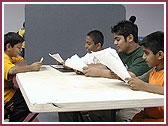
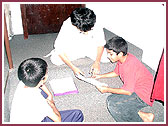
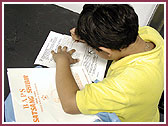
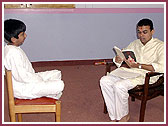
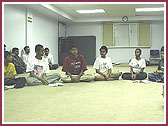
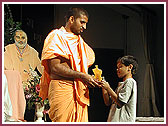
|
Thursday, October 31, 2002: Bal-Balika Adhiveshan 2002
BAPS Swaminarayan Sanstha is constantly organizing various programs for the Hindu children living in America. Under the inspirations of Pujya Pramukh Swami Maharaj, BAPS had held a regional Adhiveshan (convention) for Bal-Balikas (children) in the six different regions: Northeast, Southeast, Midwest, West, Southwest, and Canada.
Balaks and Balikas living in America and Canada constantly face a growing problem. At school, where they spend most of their day, they talk solely in English, and this becomes the language they are most comfortable with. Yet mostly all of the fundamentals of satsang, such as those found in the Vachnamrut and Swami ni Vato, and mostly all of the rituals they perform, such as arti, cheshta, etc., are in Gujarati, Hindi, and Sanskrit. These are things that are highly important in their lives, but since these three languages are foreign to a large portion of balaks and balikas, they do not want to learn them by heart as they think it is too difficult. The Bal-Balika Regional Adhiveshan 2002 was organized to motivate balaks and balikas to put extra effort into learning these fundamentals and these rituals by heart.
Balaks and balikas always want to be the best they can be, and a competition reminds them of this fact. The greatest incentive they can have to do something is winning an award and proving to themselves, their parents, and above all, their guru Pramukh Swami Maharaj that they have the ability to excel. The Adhiveshan provided them with such an incentive to work hard through the many competitions it offered. The Adhiveshan aimed to motivate the balaks to learn by heart things that are important for them to know as satsangis, even though it would be difficult for them to do. Though their main goal was to win an award, at the same time they would be learning the things that would set up an effective foundation for further progress in satsang.
The Adhiveshan primarily offered three different types of competitions: mukhpath (memorizing) competitions, talent competitions, and sports competitions. Before they could take part in any of these competitions, however, balaks and balikas had to pass a written test on basic satsang knowledge and the Gujarati alphabet. In addition, they had to pass an oral muhkpath exam consisting of arti, ashtak, and other religious hymns. After doing this, they could choose from memorizing Swami ni Vato, shlokhas and saakhis, kirtans, Vachnamrut quotations, and entire Vachnamruts. Depending on their age level, there were different levels they could attain, each giving a greater prize than the one prior to it. All balaks and balikas who met the level requirement would receive an award, and those balaks and balikas who learned the most would receive further recognition with a trophy. In the talent competitions, based on their own skills, balaks and balikas could choose from drawing, essay writing, solo singing, storytelling, prasang varnan (Incident Narration), speech, group singing, and Vato Nirupan. Finally, balaks and balikas had great fun competing in the 100 meter dash, the freethrow shootout, the soccer shootout, the sac race, the obstacle course, the hurdle race, or the “leembu-chamchi” race.
While
the children in America spend their 3 month vacation after TV,
internet and video games, these Bal-Balikas devoted their vacation
for reaching deeper in the roots of our Hindu culture. They gave
up their personal pleasures and dedicated themselves to learning
more about our religion and how to become a better person. Their
efforts were rewarded with awards being given out nation wide.
|





